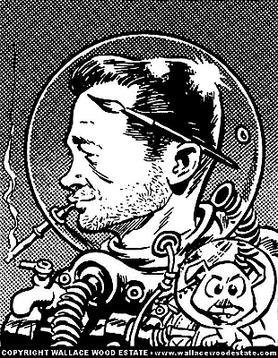
Wallace Allan Wood was an American comic book writer, artist and independent publisher, widely known for his work on EC Comics's titles such as Weird Science, Weird Fantasy, and MAD Magazine from its inception in 1952 until 1964, as well as for T.H.U.N.D.E.R. Agents, and work for Warren Publishing's Creepy. He drew a few early issues of Marvel's Daredevil and established the title character's distinctive red costume. Wood created and owned the long-running characters Sally Forth and Cannon.
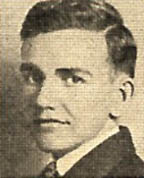
Reed Leonard Crandall was an American illustrator and penciller of comic books and magazines. He was best known for the 1940s Quality Comics' Blackhawk and for stories in EC Comics during the 1950s. Crandall was inducted into the Will Eisner Comic Book Hall of Fame in 2009.
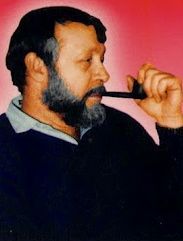
Dwight Graydon "Gray" Morrow was an American illustrator of comics, magazine covers and paperback books. He is co-creator of the Marvel Comics muck-monster the Man-Thing and of DC Comics Old West vigilante El Diablo.

Alfonso Williamson was an American cartoonist, comic book artist and illustrator specializing in adventure, Western, science fiction and fantasy.

Roy Gerald Krenkel, who often signed his work RGK, was an American illustrator who specialized in fantasy and historical drawings and paintings for books, magazines and comic books.
Warren Publishing was an American magazine company founded by James Warren, who published his first magazines in 1957 and continued in the business for decades. Magazines published by Warren include After Hours, Creepy, Eerie, Famous Monsters of Filmland, Help!, and Vampirella.
Angelo Torres is an American cartoonist and caricaturist whose work has appeared in many noteworthy comic books, as well as a long-running regular illustrator for Mad.
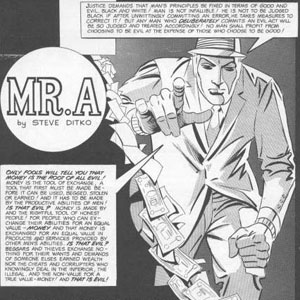
Mr. A is a fictional comic book hero created by Steve Ditko. Unlike most of Ditko's work, the character of Mr. A remained the property of Ditko, who wrote and illustrated the stories in which the character appeared entirely himself. The character first appeared in Wally Wood's witzend #3 (1967).
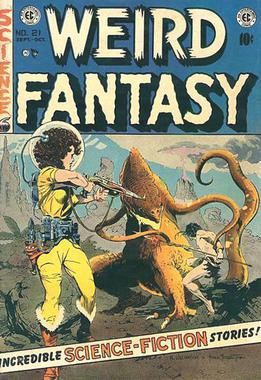
Weird Fantasy is an American dark fantasy and science fiction anthology comic that was part of the EC Comics line in the early 1950s. The companion comic for Weird Fantasy was Weird Science. Over a four-year span, Weird Fantasy ran for 22 issues, ending with the November–December 1953 issue.
Weird Science-Fantasy was an American science fiction-fantasy anthology comic, that was part of the EC Comics line in the early 1950s. Over a 14-month span, the comic ran for seven issues, starting in March 1954 with issue #23 and ending with issue #29 in May/June 1955.
William Pearson, known professionally as Bill Pearson, is an American novelist, publisher, editor, artist, comic book scripter and letterer, notable as the editor-publisher of his own graphic story publication, witzend.
Ralph Reese is an American artist who has illustrated for books, magazines, trading cards, comic books and comic strips, including a year drawing the Flash Gordon strip for King Features. Prolific from the 1960s to the 1990s, he is best known for his collaboration with Byron Preiss on the continuing feature "One Year Affair", serialized in the satiric magazine National Lampoon from 1973 to 1975 and then collected into a 1976 book.

Creepy was an American horror comics magazine launched by Warren Publishing in 1964. Like Mad, it was a black-and-white newsstand publication in a magazine format and did not carry the seal of the Comics Code Authority. An anthology magazine, it initially was published quarterly but later went bimonthly. Each issue's stories were introduced by the host character, Uncle Creepy. Its sister publications were Eerie and Vampirella.

Incredible Science Fiction was an American science fiction anthology comic published by EC Comics in 1955 and 1956, lasting a total of four issues.

Big Apple Comix is an early independent comic book published by Flo Steinberg in 1975. A historically important link between underground comix and what would later be called alternative comics, this 36-page, 63⁄4" × 93⁄4" hybrid with glossy color covers and black-and-white interiors contains 11 sometimes sexually frank stories by such mainstream creators as Neal Adams, Archie Goodwin, Denny O'Neil, Herb Trimpe, Al Williamson, and Wally Wood. The creators were mainly friends of Steinberg, working for a low page rate. Most of its stories revolve around New York City during a particularly low ebb in the city's finances, crime situation, race relations, and infrastructure.

Heroes, Inc. Presents Cannon is a two-issue comic book series that represents one of the earliest independent comics. The first issue was self-published by prominent writer-artist Wally Wood in 1969, with a second issue published by CPL Gang Publications in 1976.

Unknown Worlds of Science Fiction was a 1970s American black-and-white, science fiction comics magazine published by Marvel Comics' parent company, Magazine Management.
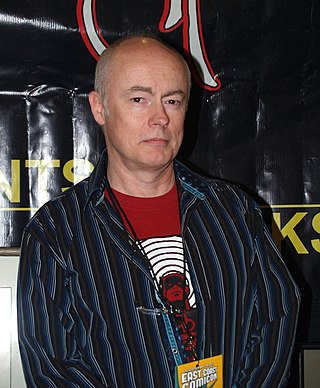
Jess David Spurlock is an author, illustrator, editor, and artist's-rights advocate best known as the founder of Vanguard Productions, a publisher of art books, graphic novels, and prints.

Good Girl Art (GGA) is a style of artwork depicting women primarily featured in comic books, comic strips, and pulp magazines. The term was coined by the American Comic Book Company, appearing in its mail order catalogs from the 1930s to the 1970s, and is used by modern comic experts to describe the hyper-sexualized version of femininity depicted in comics of the era.
The Comic and Fantasy Art Amateur Press Association (CFA-APA) was founded in 1985 by Roger Hill. Its membership consists of knowledgeable fans, creators, and collectors of comic and fantasy art who write about various subjects related to those genres. The group self-publishes approximately three times a year and each issue has a theme relating to a specific creator or subject. Currently, membership is limited to 40 persons at any one time and circulation is limited to 55 issues, making the publication itself highly collectible.
















